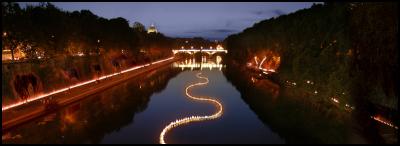A river of fire for Rome's solstice celebrations
A river of fire for Rome's solstice celebrations

Click to enlarge
A digital representation of the design to light up Rome’s Tiber River on 22 June.
MEDIA RELEASE
21 June 2007
A river of fire for Rome's solstice celebrations
On 22 June the Tiber River in central Rome will glow with the radiance of 3000 candles at the heart of an installation designed by Victoria University lecturer Associate Professor Daniel Brown for the city's Midsummer Solstice Festival.
With co-artist Kristin Jones (New York) and the help of 300 international students, Dr Brown will float a chain of 1000 candles down the centre of the river, and display the remaining 2000 on the river’s banks. Further intensifying the beauty of the installation, the half kilometre of little flames will shift in a serpentine motion as the student volunteers pull the lines of floating candles.
Commissioned by the City of Rome, Tevereterno (The Eternal Tiber) will blaze from sunset to midnight between the Sisto and Mazzini Bridges to the accompaniment of contemporary percussion compositions and electro-acoustic sounds.
Dr Brown says the snaking river of fire has been designed in homage to the Tiber River, often referred to in Italian as “the blonde serpent”.
“Symbolically the project is about extending the light on the longest day of the year until the start of the new day, encouraging the daylight to last forever,” Dr Brown says.
“I am particularly mindful, having just arrived in Rome from Wellington’s winter, that it is the shortest day of the year in Wellington and the longest day of the year in Rome. And so for me, extending the light of day becomes even more poignant! ”
The annual event draws thousands of spectators and visitors to the banks of the Tiber River in the historical centre of Rome on the night of the summer solstice. It was conceived in 2005 by the Tevereterno Association in conjunction with the City of Rome, the Rome Urban Council, and the Rome Historical Ministry to revitalise public engagement with the Tiber River and to bring international artists together with Italian composers.
Dr Brown says the event was established to stimulate dialogue between nature and urban space, the historic and the present, the European and the international.
“The idea is to create a piece of art at an urban scale in the very heart of Rome. It is a unique project for me both in terms of its scale and because it is so temporal, lasting only twelve hours.”
He says the biggest logistical problem lies with the river – at midsummer it is low and particularly fast, creating considerable drag on the half-kilometre chain. Then there’s the logistics of lighting 3000 candles.
“The candles are the same style used two thousand years ago in ancient Rome and made using the same traditional processes. The wicks are quite thick and once they are lit they are virtually impossible to extinguish. Lighting each one with a traditional match or lighter could take up to 15 minutes per candle and for this reason the water police and fire department in Rome have agreed to donate boats and their expertise to help light the candles using special torches. ”
At last year’s Tevereterno, Dr Brown and Victoria design lecturer Erika Kruger projected digital animations onto the 12m high walls of the Tiber River in homage to the She-wolf and the birth of Rome. Five students from the University’s Faculty of Architecture and Design travelled to Italy to assist with the installation.
ENDS


 GPNZ: Extended Skill Mix In Primary Care Teams Improves Patient Access And Outcomes
GPNZ: Extended Skill Mix In Primary Care Teams Improves Patient Access And Outcomes New Zealand Symphony Orchestra: Music Legend To Conduct Bach, Beethoven And Mozart With NZSO
New Zealand Symphony Orchestra: Music Legend To Conduct Bach, Beethoven And Mozart With NZSO Ministry of Health: Ministry Of Health To Look Further At Waikato Hospital Event
Ministry of Health: Ministry Of Health To Look Further At Waikato Hospital Event Emirates Team NZ: Statement From Emirates Team NZ On Auckland Hosting Of 38th America’s Cup
Emirates Team NZ: Statement From Emirates Team NZ On Auckland Hosting Of 38th America’s Cup PPTA Te Wehengarua: Draft English Curriculum Lacks Connection With Reality
PPTA Te Wehengarua: Draft English Curriculum Lacks Connection With Reality Oratia Books: Revised Edition Of Much-praised History Examines The Great War Experience Of New Zealand, Australia And Canada
Oratia Books: Revised Edition Of Much-praised History Examines The Great War Experience Of New Zealand, Australia And Canada